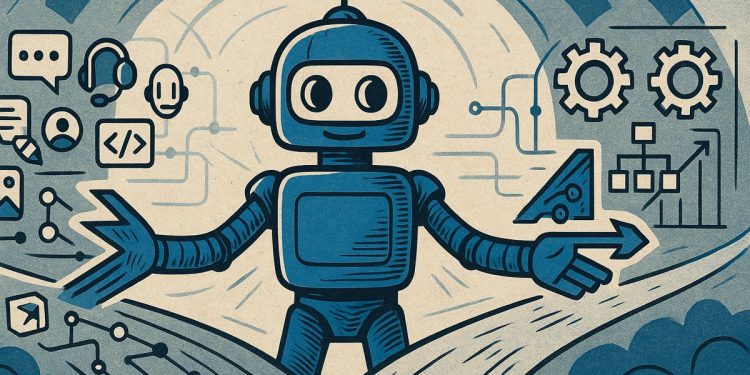Agentic AI helps companies move from small AI experiments to real, big results by letting smart systems set goals and handle complex tasks on their own. Many companies use AI tools, but only a few get real value because it’s hard to make these tools work for specific jobs. Agentic AI changes this by making AI agents that can plan, adapt, and finish work with little help from people. This means businesses can save time and money, and managers start thinking about how many digital helpers they can direct. The companies that set clear goals for their AI agents and work with them see the best success.
What is agentic AI and how does it help companies scale generative AI production?
Agentic AI bridges the Gen-AI production gap by enabling autonomous systems that set goals, execute multi-step workflows, and adapt in real time with minimal human oversight. This approach helps companies move beyond pilot projects to achieve measurable ROI, streamlined operations, and scalable vertical AI deployments.
Fewer than 10 % of vertical generative-AI pilots ever reach full production, according to the latest McKinsey survey of Fortune 500 firms, even though 92 % of them have already rolled out at least one Gen-AI tool. This “Gen-AI paradox” – high adoption, low scaled impact – is now the central conversation in C-suites during 2025. The gap is not caused by technology limits; it is the result of a structural misalignment between the two main ways we deploy AI.
Horizontal vs. vertical: why the payoff differs
| Type of deployment | Example | Speed of rollout | Value measure | Scaling record |
|---|---|---|---|---|
| *Horizontal * | Enterprise-wide Copilot, company chatbot | Days-weeks | Hard-to-isolate productivity lift | 80 % reach 1 000+ users |
| *Vertical * | AI underwriter, claims triage, predictive-maintenance agent | Months | Clear ROI per transaction | <10 % leave pilot |
Horizontal tools bring fast, diffuse gains. Vertical ones can move profit-and-loss lines, but they demand new workflows, fresh data pipelines and cultural change – exactly where most programs stall.
Enter agentic AI: closing the scaling gap
Agentic systems go beyond prompt-and-response. They can:
- Accept a goal (“reduce days-sales-outstanding by 12 %”)
- Plan multi-step processes across ERP, e-mail and CRM
- Adapt in real time to exceptions
- Operate continuously with minimal human oversight
A mid-market manufacturer that replaced its manual invoice-follow-up routine with four linked AI agents cut DSO from 47 to 31 days in one quarter – a vertical use case that finally escaped the pilot graveyard.
What the agentic layer changes
| Traditional workflow | Agentic replacement | Business effect |
|---|---|---|
| Monthly close = finance team reconciles seven systems | Agent “middle manager” supervises four sub-agents, flags only exceptions | Close window shrinks from six to three days |
New management scorecards
The hybrid workforce now asks managers not how many people they supervise, but how many digital workers they can orchestrate. Early adopters already track:
- Autonomy rate: % of tasks completed without human intervention (best-in-class >35 %)
- Alignment score: compliance with guardrails (target ≥99.5 %)
- Synergy index: human-AI hand-off time <2 min on average
Training budgets are shifting accordingly: one telecom created a ten-hour micro-certification on “prompt engineering for agents” and saw agent failure rates fall from 8 % to 1.2 % within a month.
Four practical moves for 2025
- Pick one pain-point process that owns a KPI (e.g., cash conversion cycle).
- Re-design the workflow first; automation second.
- Stand up a three-person “agent pod” – product owner, data engineer, AI ethicist – to run sprints.
- Track only two metrics at launch: error rate and KPI delta.
The companies that treat agents as colleagues – giving them goals, feedback and boundaries – are the ones finally turning Gen-AI’s promise into ledger-grade value.
What exactly is the “Gen AI paradox” and why does it matter in 2025?
The Gen AI paradox is the gap between heavy AI investment and the stubbornly low rate of scaled impact. Despite 92 % of Fortune 500 firms having adopted generative AI in some form, fewer than 10 % of vertical use cases ever leave the pilot stage. In other words, companies can spin up a chatbot in weeks but struggle to embed AI into core processes that actually move revenue or margin.
Key takeaway: easy horizontal tools (think enterprise-wide copilots) deploy quickly yet deliver diffuse gains, while high-value vertical applications (e.g., AI-driven loan underwriting) stall because they demand workflow redesign, data integration and sustained change management.
How can agentic AI break the pilot-to-production logjam?
Agentic AI systems act as goal-seeking digital workers that can:
- Interpret objectives without step-by-step instructions
- Orchestrate multi-step workflows across departments in real time
- Self-correct when conditions change
Early adopters report that onboarding time for new hires drops by up to 50 % when AI agents handle documentation, access provisioning and first-week task guidance. One global manufacturer now uses agents to auto-schedule maintenance across 30 plants, cutting downtime 15 %.
Critical insight: agentic AI only pays off when firms re-architect legacy workflows instead of layering agents onto broken processes.
What new management skills are required to supervise a hybrid workforce?
Managing humans plus AI agents is nothing like traditional team leadership. The emerging “digital span of control” metric asks: how many autonomous agents can one manager safely oversee?
Core skills for 2025 include:
- Verification of AI outputs against ground truth
- Boundary setting – clear guardrails for when agents can act alone
- Risk escalation protocols for edge cases
- Continuous re-training loops as business rules evolve
Training budgets are pivoting: Gartner estimates that 34 % of 2025 L&D dollars will target AI-agent supervision rather than classic people management.
Which performance indicators should replace yesterday’s KPIs?
Traditional dashboards track human productivity; hybrid teams need bi-modal KPIs:
| Human KPIs (legacy) | Agentic AI KPIs (2025) |
|---|---|
| Tickets closed per rep | Autonomy rate (% tasks finished without human hand-off) |
| Average handle time | Alignment score (decisions matching policy & ethics checks) |
| Net Promoter Score | Human-AI synergy index (combined output vs. siloed efforts) |
Companies that publicly disclose blended KPIs in earnings calls have seen analyst price-target upgrades 1.4× more often than peers, according to an MIT CISR working paper (July 2025).
Where should leaders start next week?
- Pick one high-value vertical process (e.g., claims triage, supply-chain exception handling).
- Host a 90-minute red-team workshop to surface every workflow friction point.
- Draft a single KPI that captures human-plus-agent performance.
- Allocate one “agent wrangler” – a junior analyst who will spend 50 % of their time curating agent prompts and guardrails.
Remember: agentic AI rewards re-design, not retrofit.



















